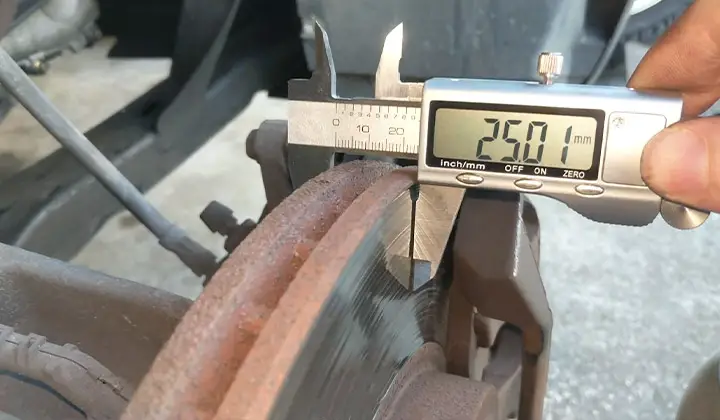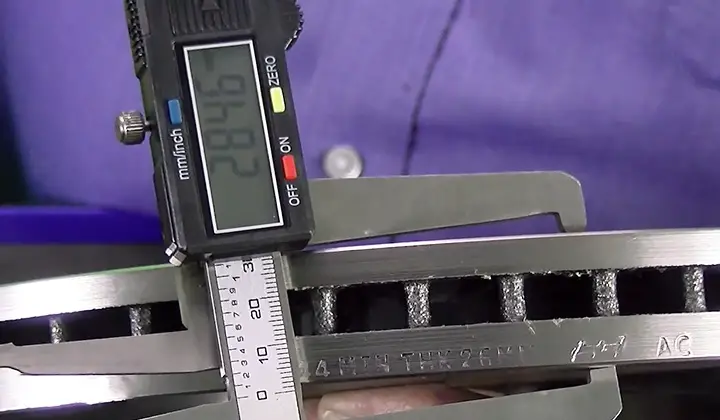The thickness of your rotor can have a big impact on the performance of your vehicle. Thin rotors will not provide enough stopping power and may result in skidding or poor braking.
On the other hand, thick rotors will tend to be more expensive but they are also more effective at providing consistent stopping power.
When you brake, the pads on your tires push against the rotors. The thickness of these disks is important because it determines how much resistance they offer to the motion of your car.
Too thin a rotor will not stop your car from moving quickly, while too thick a rotor can actually cause damage to the brakes and tire.
Ultimately, this will depend on a variety of factors including the make and model of your vehicle, driving habits, and climate conditions.
Additionally, the type of braking system that you are using will also play a role in determining how thick the rotors need to be.
Contents
How Thick Should the Rotors Be
Generally, thicker rotors will provide better stopping power in slippery conditions or during snowy weather. If you live in a wet climate, it is also important to consider the weight of the precipitation that falls each year.

It is advisable to consult with an expert before making any changes to your car’s brakes because incorrect installation can result in serious accidents. Properly selecting replacement parts will help ensure lasting safety and performance.
Ideal Thickness of the Rotors
When you’re driving on the road, your car’s brakes need to stop quickly. That means the pads must be able to make contact with the rotors and create a friction force that slows down the car.
Ideally, the thickness of a rotor should be just enough so that it can create this necessary friction. However, not all cars are created equal – some may have thinner rotors than others.
In these cases, you’ll want to adjust your brake pad ‘wear’ or replacement frequency in order to compensate for this difference in rotor thickness.
There is no specific answer to this question as it depends on the type of driving you to do and your car’s individual characteristics.
However, a good rule of thumb is to ensure that the rotor thickness is at least 1/4 inch (6 mm).
Here is a chart of the thickness that various vehicles needed:
Source: promasterforum
Thicker Rotors Are Better
Thicker rotor discs are better at stopping the car at a shorter distance. This is because they can rotate more quickly and create more friction with the road.
Reduced Stopping Distance
Thicker rotors will reduce the stopping distance and make it easier to stop on wet or icy roads. This is because thicker rotors can effectively disperse the kinetic energy that is created when you brake, making braking more efficient.
Improved Braking Performance
Thin rotor blades are designed to dissipate heat quickly, which results in poor braking performance and a higher chance of overheating your brakes within a short period of time.
Thick rotor blades allow for greater thermal dissipation, meaning your brakes will remain cool under pressure and last longer without overheating or breaking down.
Longer Durability
A thicker rotor also means that it will be more durable overall; this means that less wear and tear will take place over time, resulting in an extended lifespan for your brakes pads and discs
How To Identify if the Rotors Are Thin
If you’re noticing that your car is losing a lot of speed when driving in the rain, it might be time to have the rotors checked. Thin rotor blades can cause your car to lose traction and skid.

The ideal thickness for rotors depends on the type of tires you have and how often they need to be replaced, but generally, they should be between 1/32nd and 1/8th inch thick.
Poor Fuel Economy
Thin, poorly functioning rotors can cause decreased fuel economy in your car. This is because the rotor doesn’t have enough surface area to efficiently convert the energy from the engine into forwarding motion.
Brake Doesn’t Work Well
When you brake, your car needs to create a lot of heat in order to stop quickly and safely. If there are thin or ineffective rotors, this heat won’t be effectively dissipated and could lead to braking problems down the road.
Hesitation and Difficulty Steering
A weak or malfunctioning steering system can be caused by low levels of power generated by your wheels due to an ineffective rotor assembly.
This means that you will experience a hesitation when turning as well as difficulty maneuvering around obstacles on roads and highways.
Chirping Noise When Driving at Higher Speeds
If your rotors aren’t providing adequate protection against debris while driving at high speeds, you may hear a chirping noise coming from inside your car whenever you hit something small like pebbles or dust particles on the road surface.
Reduced Mileage
Thin rotors can also reduce fuel efficiency due to reduced stopping power and increased wear on brake components over time. This can lead to decreased mileage and even require the replacement of your brakes in the long run.
Risk for Injuries
If you have any doubts about whether your brakes need to be replaced, it’s always safest to consult with a qualified mechanic before making any changes yourself.
Making small changes that don’t address the underlying issue might result in big problems down the road that you won’t even realize until it’s too late.
How To Choose the Right Thickness of the Rotors of Your Vehicle
The thickness of the rotor is one factor that determines how well your vehicle will stop in a hurry. The thicker the rotor, the more stopping power it has.
However, there are also other factors to consider when choosing a rotor thickness.
For example, thick rotors can be heavy and difficult to install. So make sure you weigh all of your options before selecting the right thickness for your car. There is no one answer to this question.
Different vehicles will require different thicknesses of rotor for optimum performance. Factors that can affect the choice include vehicle weight, speed, terrain, and weather conditions.
Ultimately, you will need to test your own vehicle in order to find the best rotor thickness for it.
Type Of Brakes You Have
There are three main types of brakes: manual drums/rotors, hydraulic discs/rotors, and electronic systems with regenerative braking (eBrake).
Each type has its own benefits and drawbacks so it is important to choose the right one for your needs before making any major upgrades or repairs.
Pressure Rating and Weight Capacity
Different vehicles have different pressure ratings (between 130-170 PSI) along with varying weight capacities (from around 2kg up to 8kg).
It is important to check these specs before buying new brake pads or upgrading existing ones – otherwise, you could end up damaging both your car AND equipment.
If you’re looking to improve your car’s performance, it is important to first identify what type of brakes you need and how much pressure they should withstand.
In general, cars require between 130-170 PSI for safe operation, but this number varies depending on the make and model of your vehicle as well as its weight and size.
How Thick Does a Rotor Have to Be to Turn?
The size of rotors like thickness of a rotor is a very important factor to consider when designing an airfoil. This is because the airfoil is designed to create lift. The thicker the rotor, the more lift it creates.
The thickness of a rotor can be measured by how many wavelengths it takes to cover its surface area.
For example, if you were to take two identical rotors and place them on top of each other, they would have twice as much surface area as one rotor.
If you were to take one rotor and place it on top of another, they would have four times as much surface area as one rotor.
FAQs
Where Is the Minimum Thickness on Rotors?
The minimum thickness on rotors is 0.2 inches, which is the thickness of a credit card.
What Is the Minimum Brake Disc Thickness?
The minimum brake disc thickness is 1/16 inch or 1.6 mm.
How Long Rotors Should Last?
A rotor should last for at least 70,000 miles of continuous use.
Conclusion
In order to ensure that your car is able to stop in time, the rotors must be thick enough. The minimum thickness required by law varies from state to state, but generally, it is around 0.6 inches (15 millimeters).
However, this number can vary depending on a variety of factors such as the condition of the rotor and the type of braking system used in your car.
The thickness of the rotor can depend on a variety of factors including the type and make of your vehicle, how often it’s been serviced, and its driving habits.
